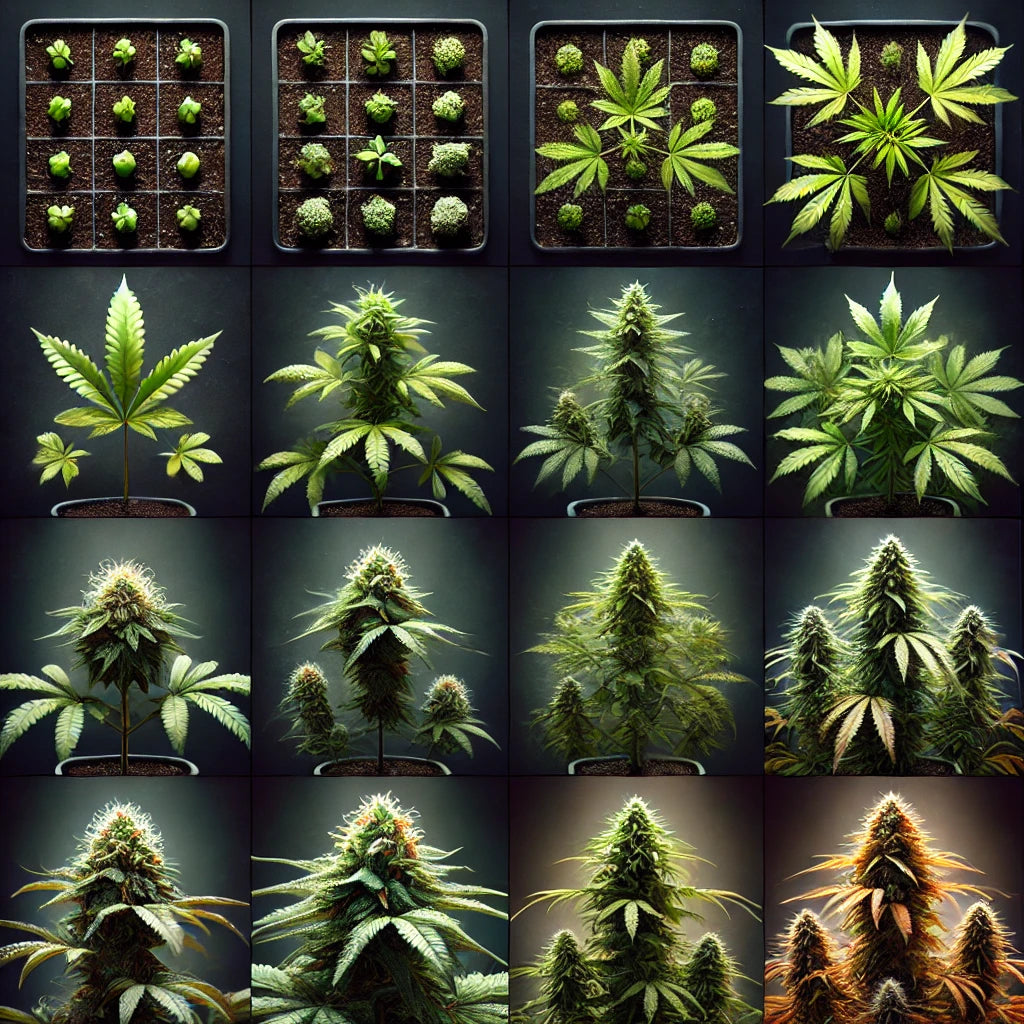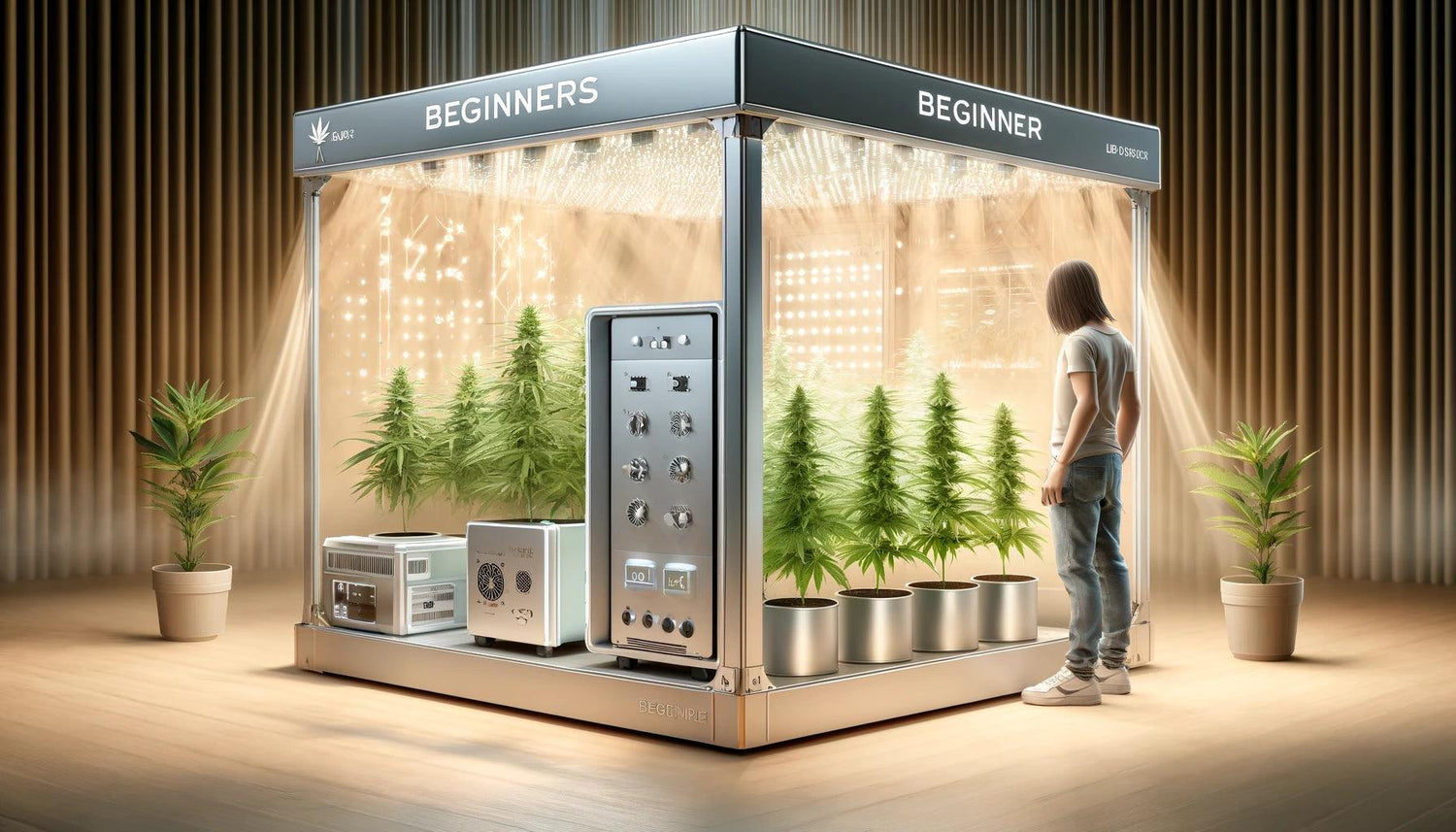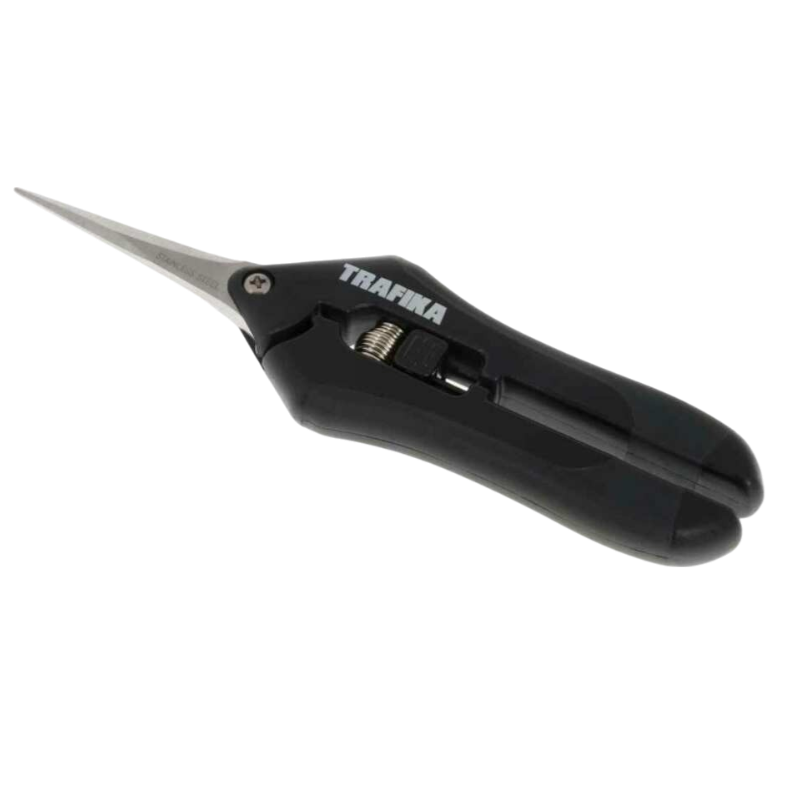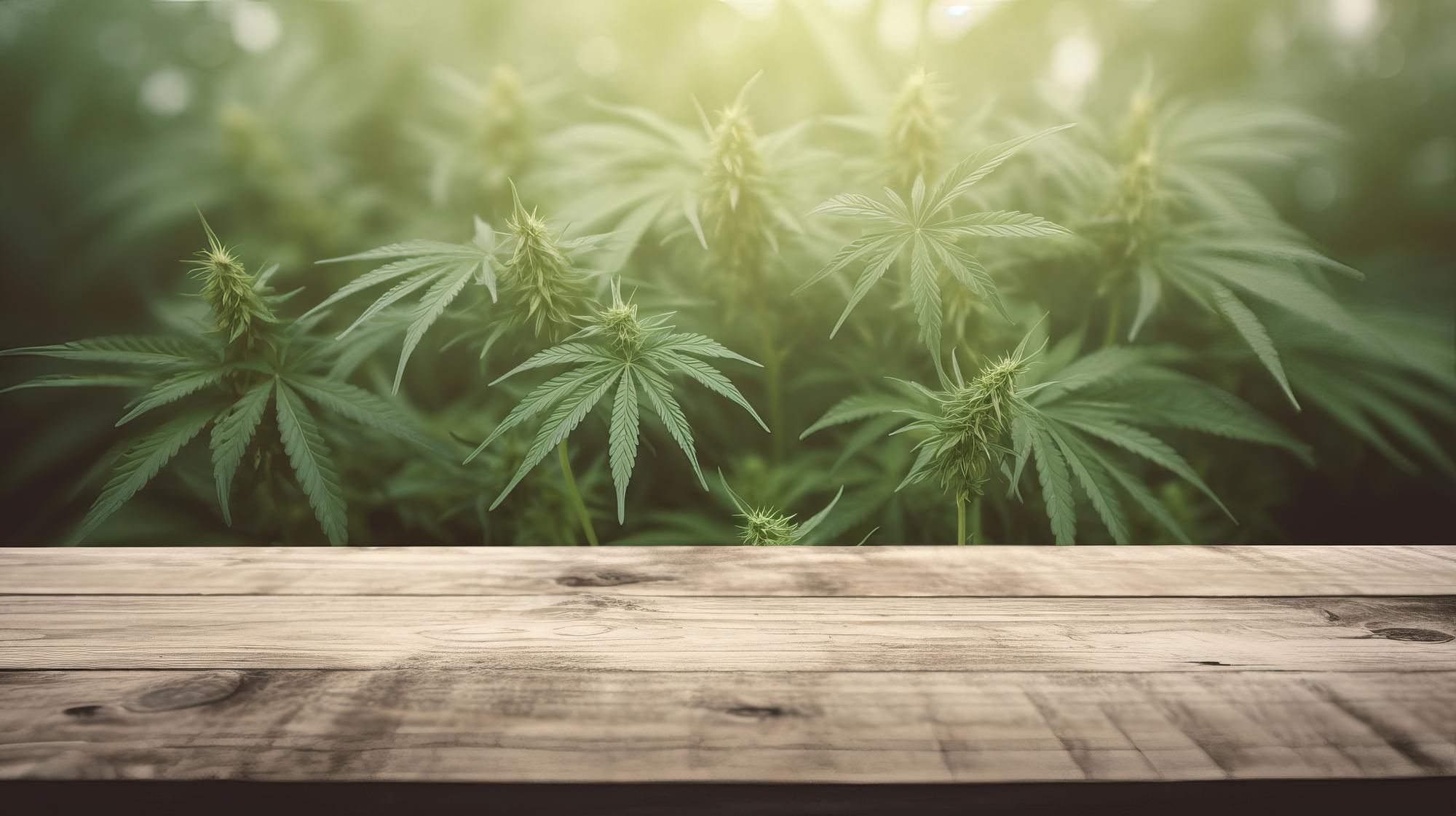1. Choosing the perfect grow box: size, material and budget
Choosing the right grow box is the first and perhaps most important step on your path to successful cannabis cultivation. There are a few crucial factors you should consider.
Size: How much space do you really need?
The size of your grow box depends on several factors. First of all, how many plants do you want to grow? For beginners, we recommend starting with 2-4 plants. A box of about 80x80x160 cm is ideal for this. Also keep in mind that you will need space for ventilation, lighting and other equipment. You should also consider the available space in your home.
Material: What you should pay attention to
Most grow boxes are made of fabric or metal. Fabric boxes are usually cheaper and easier to transport, while metal boxes are more robust and durable. With both options, make sure they have an opaque outer shell and a reflective interior to make the most of the light.
Budget: Quality has its price
A good grow box doesn't have to be expensive, but quality definitely has its price. Expect to pay around 100-300 euros for a solid starter box. Remember that a high-quality box is the better investment in the long run, as it works more efficiently and lasts longer.
| Box size | Suitable for | Average price |
|---|---|---|
| 60x60x140cm | 1-2 plants | 80-150 € |
| 80x80x160cm | 2-4 plants | 120-250 € |
| 100x100x200cm | 4-6 plants | 200-400 € |
Keep in mind that a larger box is not automatically better. Choose the size that suits your needs and possibilities. A box that is too big can be harder to control and use unnecessary energy.
With the right grow box you lay the foundation for successful cannabis cultivation. Take the time to compare different models and choose a box that suits your needs. In the next section we will take a look at the important topics of lighting and ventilation - two crucial factors for healthy and productive plants.
2. Lighting and ventilation: the heart of your cannabis cultivation
After you have chosen the perfect grow box, it is time to address two of the most important aspects of successful indoor growing: lighting and ventilation. These two factors are crucial for the growth and health of your cannabis plants.
Optimal lighting for maximum growth
The right lighting is essential for the photosynthesis of your plants. There are various lighting options for cannabis grow boxes:
- LED lamps: energy efficient and with low heat generation
- HPS lamps (sodium vapour lamps): High light output, but also high heat generation
- Energy saving lamps: inexpensive but less effective than LED or HPS
For beginners, we recommend LED lights. They offer a good efficiency to cost ratio and are easy to use. Make sure your light covers the full light spectrum, as cannabis needs different light in different growth phases.
Ventilation: Fresh air for healthy plants
Good ventilation is essential to prevent mold and disease and to create optimal growing conditions. An effective ventilation system consists of three components:
- Exhaust fan: Removes warm, humid air from the box
- Air inlet: Lets fresh air into the box
- Internal fan: ensures air circulation inside the box
The size of your ventilation system depends on the size of your grow box. A rule of thumb is that you should completely replace the air volume of your box at least once per minute.
Finding the right balance
It is important to match lighting and ventilation. Strong lighting generates more heat, which requires more ventilation. Here is an overview of a typical beginner grow box:
| Box size | Recommended lighting | Recommended ventilation |
|---|---|---|
| 80x80x160cm | 250-400W LED | Exhaust fan: 200-300 m³/h |
Note that these values are guidelines and need to be adjusted according to specific conditions. Over time, you will develop a feel for what your plants need.
With the right combination of lighting and ventilation, you can create optimal conditions for your cannabis plants. In the next section, we will look at how to provide your plants with the right nutrients and which substrate is best.
3. Nutrients and substrates: How to ensure your plants thrive
Now that we have laid the foundations for lighting and ventilation, let's turn our attention to another crucial aspect for healthy and productive cannabis plants: the right nutrients and substrates.
Choosing the right substrate
The substrate is the foundation in which your plants grow. There are various options, but for beginners we recommend a high-quality, pre-fertilized soil specifically for cannabis. This provides a good balance of nutrients, water retention and aeration of the roots.
Alternatives to the classic soil substrate are:
- Coconut soil: Light, well aerated, but low in nutrients
- Rockwool: Ideal for hydroponic systems
- Perlite mixtures: Improve drainage and aeration
For your first grow box, a mixture of 70% cannabis-specific soil and 30% perlite is a good choice. This combination provides sufficient nutrients and optimal root aeration.
Nutrients: The food for your plants
Cannabis requires different nutrients in different amounts during its growth. The three main nutrients are:
| nutrient | function | Needs in the growth phase | Requirements in the flowering phase |
|---|---|---|---|
| Nitrogen (N) | Leaf development | High | Low |
| Phosphorus (P) | Root and flower development | Medium | High |
| Potassium (K) | General health and stress resistance | Medium | High |
In addition, your plants need trace elements such as magnesium, calcium and iron. Many cannabis-specific fertilizers already contain a balanced mix of these nutrients.
Fertilization: Less is often more
When it comes to fertilizing, it's better to be safe than sorry. Over-fertilizing can lead to nutrient burn and damage your plants. Start with about half the manufacturer's recommended dose and increase slowly if necessary.
A typical fertilization plan might look like this:
- Week 1-2: No additional fertilization necessary (pre-fertilized soil)
- Week 3-4: 1/4 of the recommended dose of growth fertilizer
- Week 5-6: 1/2 the recommended dose of growth fertilizer
- From week 7 (flowering phase): Switch to flowering fertilizer, start with 1/2 dose
Watch your plants closely. Yellow leaves can indicate nutrient deficiencies, while brown leaf tips are often a sign of over-fertilization.
With the right substrate and a balanced supply of nutrients, you lay the foundation for healthy, strong cannabis plants. In the next section, we'll look at controlling temperature and humidity - two other key factors for a successful harvest.
4. Temperature and humidity: the key to success
Now that we've covered nutrients and substrates, we'll look at two other crucial factors for your cannabis cultivation: temperature and humidity. The right balance of these two elements is essential for healthy plants and optimal yields.
The ideal temperature for cannabis
Cannabis thrives best in a certain temperature range. Temperatures that are too high or too low can slow growth or even cause damage. Here are the optimal temperature ranges for different growth phases:
- Germination and seedlings: 20-25°C
- Vegetative phase: 22-28°C
- Flowering phase: 20-26°C
Note that the temperature should drop by about 5-10°C at night. This temperature difference promotes plant growth and simulates natural conditions.
The right humidity
The optimal humidity varies depending on the growth phase of your plants. Here is an overview:
| Growth phase | Optimal humidity |
|---|---|
| Germination and seedlings | 70-80% |
| Vegetative phase | 50-70% |
| Early flowering phase | 40-50% |
| Late flowering phase | 30-40% |
Too high humidity in the late flowering phase can lead to mold growth, while too low humidity can slow growth.
Control and adjustment
To control the temperature and humidity in your grow box, you need the following equipment:
- Thermometer and hygrometer: For monitoring temperature and humidity
- Fan: To regulate temperature and air circulation
- Heating: If the temperature is too low (especially at night)
- Humidifier or dehumidifier: To adjust the humidity
A tip for beginners: invest in a combined thermometer/hygrometer with data recording. This way you can observe fluctuations over longer periods of time and react accordingly.
The Vapor Pressure Deficit (VPD)
Advanced growers also pay attention to the VPD, which describes the interaction between temperature and humidity. An optimal VPD promotes water absorption and nutrient transport in the plant. For beginners, however, it is sufficient to concentrate on the guidelines mentioned above.
Watch your plants closely. If the leaves are drooping, it might be too warm. If the edges of the leaves are curling up, it might be too cold. Over time, you will develop a feeling for what your plants need.
By properly controlling temperature and humidity, you can create optimal conditions for your cannabis plants. In the last section, we will look at how to optimally care for your plants and monitor their growth.
5. Care and monitoring: your daily tasks as a grower
Now that we have covered the basic aspects of your cannabis grow box, we will now turn to your daily tasks as a grower. Regular care and precise monitoring are crucial to the success of your cannabis cultivation.
Establish daily routines
A fixed routine will help you not to overlook anything important. Here is an example of a daily checklist:
- Check temperature and humidity and adjust if necessary
- Check plants for signs of stress or disease
- Check watering requirements (finger test in the soil)
- Check ventilation
- Document growth progress
Try to do these checks at the same time of day each day to ensure consistency in your observations.
Irrigation: The art of the right measure
Proper watering is crucial for healthy plants. Overwatering is one of the most common mistakes made by beginners. Here are some tips:
- Only water when the top layer of soil is dry (finger test)
- Water slowly and evenly until water comes out of the drainage holes
- Ensure good drainage to avoid waterlogging
- Adjust the amount of water to the growth phase (more in the flowering phase)
Plant care and training
Regular care helps your plants reach their full potential:
| measure | time | To use |
|---|---|---|
| Removing dead leaves | If required | Prevents mold growth |
| Topping | Early vegetative phase | Promotes bushy growth |
| LST (Low Stress Training) | Vegetative phase | Optimizes light absorption |
Be careful when using these techniques and educate yourself thoroughly before using them.
Detecting diseases and pests
Regular checks will help you identify problems early. Pay particular attention to:
- Discoloration or spots on the leaves
- Unusual growth forms or deformities
- Small insects or their traces (e.g. spider mites)
- Mold or mildew, especially in the flowers
If you notice signs of problems, react quickly, but don't rush into anything. Often, simply adjusting the environmental conditions can help.
Documentation: Your path to success
Keep a grow diary in which you record important data and observations:
- Daily temperature and humidity values
- Fertilizer application (amount and type)
- Irrigation intervals
- Growth progress (height, number of leaves, etc.)
- Problems encountered and their solutions
These records will help you learn from experience and continually improve your cultivation methods.
With consistent care and precise monitoring, you create the best conditions for a successful harvest. Remember: every grow is a learning opportunity. Over time, you will develop a feel for the needs of your plants and achieve better and better results.

















